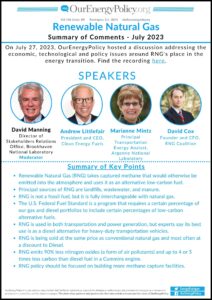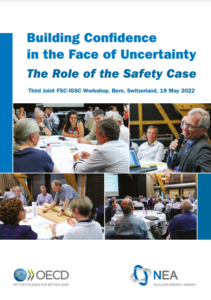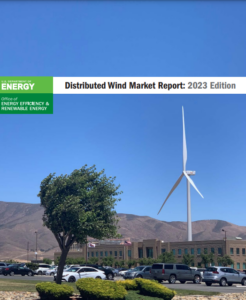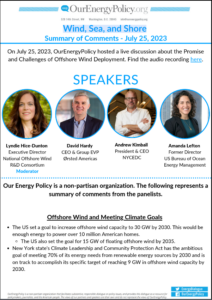The OurEnergyLibrary aggregates and indexes publicly available fact sheets, journal articles, reports, studies, and other publications on U.S. energy topics. It is updated every week to include the most recent energy resources from academia, government, industry, non-profits, think tanks, and trade associations. Suggest a resource by emailing us at info@ourenergypolicy.org.
Resource Library
“All Electric Construction: A Good Deal” details the cost saving opportunity for constructing new homes to be all-electric and avoiding gas pipeline extensions.
All-electric building codes lead to lower construction costs in Oregon by encouraging developers to bypass the cost and complexity of installing new gas lines. These homes have roughly the same utility bills as mixed-fuel homes, which use both gas and electricity. Those savings are projected to improve over time as gas prices rise.…
On July 27, 2023, OurEnergyPolicy hosted a discussion addressing the economic, technological and policy issues around RNG’s place in the energy transition. This resources summarizes the discussion from that event.…
View Full ResourceIn May 2022, the Forum on Stakeholder Confidence (FSC) and the Integration Group for the Safety Case (IGSC) held a Joint Workshop with stakeholders from Germany, Sweden and Switzerland to assess the challenges in communicating scientific safety evidence to non-technical stakeholders and to find ways to effectively communicate such knowledge to increase confidence in the safety case. The workshop also provided an opportunity to learn from local stakeholders in Switzerland and abroad about fostering confidence among non-technical audiences and creating engagement in the waste repository development process. This summary report presents the results and general findings of the workshop.…
View Full ResourceThe annual Distributed Wind Market Report provides stakeholders with market statistics and analysis along with insights into market trends and characteristics for wind technologies used as distributed energy resources. This report presents the distributed wind market from 2003 through 2022. Key findings with respect to installed capacity, deployment trends, customer types, incentives, policies, installed costs and performance, and the future outlook are presented in the executive summary.…
View Full ResourceCDR refers to anthropogenic activities that remove CO2 from the atmosphere and store it durably in geological, terrestrial, or ocean reservoirs, or in products, according to the Intergovernmental Panel on Climate Change (IPCC). As of June 2023, more than 5,000 companies—representing nearly one-third of global market cap—have committed to reducing their emissions.
As more companies establish decarbonization and net zero strategies, carbon removal credits will need to scale considerably given current supply shortages. However, the voluntary carbon market faces several barriers to scale. Further complications arise when considering the variety of carbon credit types which vary in quality, permanence, additionality, …
View Full ResourceWhilst digital technology is key to modern industrial processes ranging from oil and gas extraction to power generation and chemicals processing, the energy transition imperative calls for a step-up in technology sophistication and speed.
Our latest whitepaper, produced from expert interviews with AVEVA digital leaders, unpacks this dual-challenge and explores how technology can support engineers and operations team to efficiently deliver information whenever and wherever it is needed. …
View Full ResourceAttitudes about a hydrogen economy vary dramatically. Some say that hydrogen is one of the most difficult substances to work with and most of what we hear is hype. Others claim that hydro gen holds enormous environmental and economic promise. In 2017 the Hydrogen Council offered a vision of the hydrogen economy for year 2050 with an annual income of $2.5 trillion dollars and 30 million new jobs. Unlike fossil fuels, when hydrogen is burned it produces water, not carbon dioxide (CO2). Hydrogen networks are being planned in Europe and large demonstration projects are underway in the United States and …
View Full ResourceThe GreenBiz 23 Comms Summit, held February 13—14, 2023, in Scottsdale, Arizona brought together nearly 200 communications, legal and sustainability professionals from large companies along with outside experts on sustainability and ESG communications.
The hands-on, roll-up-your-sleeves program organized by GreenBiz Group featured real-world communications and messaging case studies, with feedback from investors, activists, journalists, policymakers and peers. Participants followed the Chatham House rule, fostering an environment of trust in which individuals and organizations cannot be identified without permission. This report summarizes the key takeaways.…
View Full ResourceOn July 25, 2023, OurEnergyPolicy hosted a live discussion about the Promise and Challenges of Offshore Wind Deployment.
This resource summarizes the discussion from that event.…
View Full ResourceThe California Public Utilities Commission (CPUC) sought support for the development of database schema specifications for a bi-directional data portal that would foster cross-jurisdictional collaboration necessary to improve resilient energy infrastructure planning processes. This technical assistance activity involved Berkeley Lab researchers reviewing 34 local/tribal government hazard mitigation plans to assess (1) the natural hazards that communities are most concerned about; (2) the variety of–and terminology used to describe–critical community infrastructure; and (3) the availability of GIS information that could be incorporated into CPUC-mandated “Microgrid Planning Portals”. In addition, we develop a common, but generic data taxonomy showing what fields to …
View Full Resource







